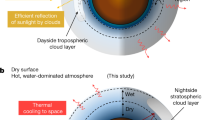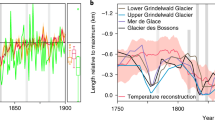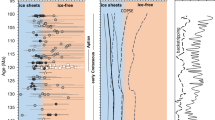Abstract
DENUDED of its liquid envelope, the figure of the earth may be compared to that of a tomato having a flat lump affixed at one side of the depression from which the stem has been removed. Not a close parallel—even a caricature—but I trust a true one, and successful caricatures are full of meaning. It is necessary to place the tomato in such position that the depression represents the deep basin of the Arctic Ocean, the bulging portion which is opposite will then represent the flat ice-dome of the Antarctic continent, and the artificial lump beside the depression the entirely similar though somewhat smaller ice-covered continent of Greenland. Both of these domes rise to elevations of nearly two miles above sea.
This is a preview of subscription content, access via your institution
Access options
Subscribe to this journal
Receive 51 print issues and online access
$199.00 per year
only $3.90 per issue
Buy this article
- Purchase on Springer Link
- Instant access to full article PDF
Prices may be subject to local taxes which are calculated during checkout
Similar content being viewed by others
References
H. Mohn, The Norwegian North Polar Expedition, 1893–96, Scientific Results, edited by Fridtjof Nansen, vol. 6, London, 1905, Meteorology, P. 572.
W. H. Hobbs, Zeitsch. f. Gletscherk., vol. 5, 1910, pp. 110–120; Proc. Am. Phil. Soc., vol. 49, 1910, pp. 99–104; "Characteristics of Existing Glaciers" (Macmillan, 1911), chaps, ix., xvi., and especially the Afterword; "The Rôle of the Glacial Anticyclone in the Air Circulation of the Globe", Proc. Am. Phil. Soc., Vol. 54, 1915, pp. 185–225 figs. II; "The Mechanics of the Glacial Anticyclone illustrated by Experiment", NATURE, July 22, 1920; "The Glacial Anticyclones, the Poles of the Atmospheric Circulation", monograph soon to be published in book form by the University of Michigan.
V. Bjerknes, "The Meteorology of the Temperate Zone and the General Atmospheric Circulation", NATURE, vol. 105, June 20, 1920, pp. 522–524.
V. Bjerknes, "The Importance of Wireless Weather Reports from Greenland", Monthly Weather Review, Washington, Jan. 1922, pp. 16–19.
J. Bjerknes and H. Solberg, "Life Cycle of Cyclones and the Polar Front Theory of Atmospheric Circulation", Geofysiker Publikationer, vol. iii., No. 1, 1922, p. 14.
See A. J. Henry, Monthly Weather Review, Sept. 1922, pp. 468–474.
H. Rink, "Grönland", 1860, pp. 111–112.
"Medelelser om Grönland", vol. 9, 1889, pp. 348–408.
E. von Dryjalski, "Grönland-Expedition der Gesellschaft für Erdkunde", 1891–93, Berlin, 1897.
Cf. Rink, op. cit.
D. Mawson, Geogr. Journ., vol. 44, 1914, pp. 257–286.
Author information
Authors and Affiliations
Rights and permissions
About this article
Cite this article
HOBBS, W. The Source of the Cold Air of the North “Polar Front”1. Nature 116, 519–521 (1925). https://doi.org/10.1038/116519a0
Published:
Issue Date:
DOI: https://doi.org/10.1038/116519a0
Comments
By submitting a comment you agree to abide by our Terms and Community Guidelines. If you find something abusive or that does not comply with our terms or guidelines please flag it as inappropriate.



